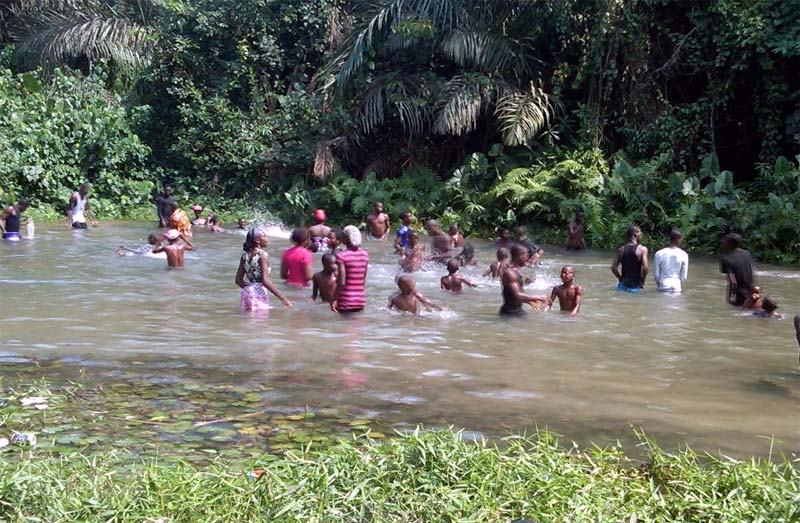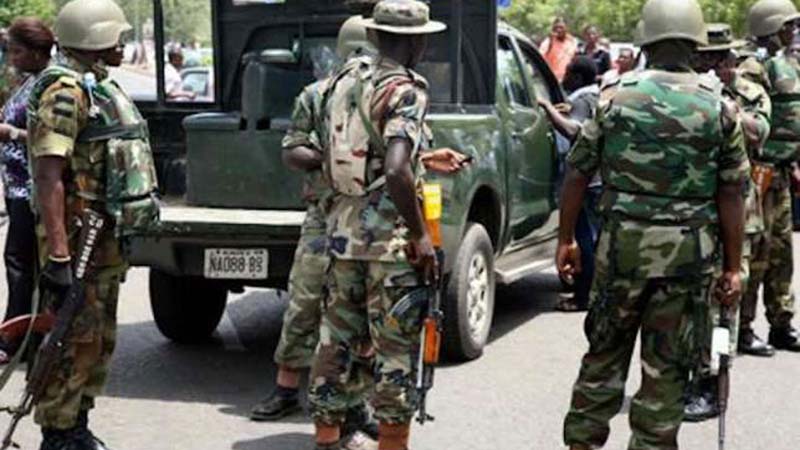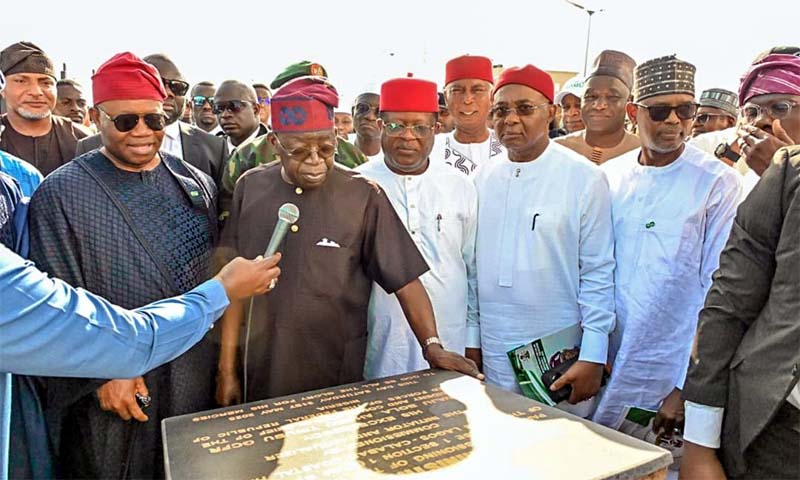As a young man growing up among several cultures across the world, the stories of Ohafia and my little community Isiugwu as I leaned it helped me overcome so much of the dangers and affairs of life people take for granted and so much more
BY UDUMA KALU (Ed for Use by Njoku SaintJerry A)
Know your history; take time to reach out to your people and reconnect with your roots, there is a sense of pride and confidence in having a deep understanding of your culture, historical exploits and memories of what makes a people strong, weak or withdrawn. Ohafia is a classic cultural community worth the attention and deep study of every sons and daughters, resident and the Diaspora and this brief historical introduction is put together by former Guardian & Vanguard News Editor Uduma Kalu as a preview to a larger historical work in progress is worth the reading time and data of every sons and daughters from the community or rivers, hills and valleys, Isiugwu Ohafia.
As a young man growing up among several cultures across the world, the stories of Ohafia and my little community Isiugwu as I leaned it helped me overcome so much of the dangers and affairs of life people take for granted and so much more, we were brought up to fear nobody but respect all and honour our elders.
Now enjoy the story of Ohafia beginning from Isiugwu
Isiugwu Ohafia is located in the south of Ohafia, in Ohafia Local Government Area, Abia State, Nigeria. It shares boundaries with other Ohafia towns of Akanu, Ebem, Ndi Uduma in Ohafia LGA, and with Ozu Abam, Ndi Oji Abam and Ndi Okereke Abam, Ndi Okorie Abam in Arochukwu LGA.
A cursory look at the history of Isiugwu Ohafia shows that the community is an assemblage of people from diverse places from far and near. Reports indicate that some came from the Ohafia towns, Abam, Okposi, Ihechiowa, bibio and Efik etc. All of these people founded or were allotted places, and they settled in the town peacefully. The founding of Isiugwu Ohafia was therefore not a one person’s effort.
Though a warrior people, the different groups that came together to become Isiugwu Ohafia did not fight any war to dominate or subjugate anybody. They all came together under the Udumali monarchy after a legal proclamation by all Ohafia at the Achichi Ohafia, the Ohafia Council located at Elu Ohafia, the traditional headquarters of the Ohafia nation.
The different people from their different settlements then resolved to live together peacefully to become a strong and united Isiugwu Ohafia community.
IN THE BEGINNING – INTERVIEW WITH CHIEF NJOKU UKARIWE
There were four settlements that made up what is today known as Isiugwu Ohafia. Before the arrival of the man now considered as the founder of the community, Isiugwu Ohafia, four settlements were said to have been in existence.
The first settlement was said to have been at Iyi Nshi at the Odeji farm area. These people were said to be of the Umu Okwu maternal family today. The people were also attending the Ohafia general meetings at Elu Ohafia. No one is sure about this information, though.
For a settlement to earn an official recognition in Ohafia and attend its meetings, there must be a settlement. A fire that indicated the founding of the settlement must be made, and information must be passed to the Ohafia monarch and council at Elu for official recognition.
The second settlement was Ndi Nsuru, founded by Nsuru Oke. He settled near what is today Ndi Agwu. That was before Ndi Agwu was founded. Nsuru already had his own ikoro, a wooden drum, and was having traditional ceremonies. This means Nsuru indeed had an ikoro before the entire Isiugwu did. Nevertheless, Nsuru did not aspire to become head of the community as later events showed.
The third settlement was at the Nde Ogu. The place was at the Kalu Okorie area, on the right of the junction of the road going to Ndi Oji Abam. Their settlement was towards Orua Nnem Awusi, at the area where you do not pick up things, even if they fall off from you. It was at a place called Iyi Ugbo.
The fourth was the Udumali group. While we are yet to know how the first three arrived Isiugwu and the place they migrated from, the story of the fourth person seems clearer than the rest.
A table of Isiugwu monarchy published in Elevation 2016: Igba Uche Festival Magazine of Onyirimba Age Grade-Isiugwu Ohafia-Abia State, edited by Mr. Emmanuel Awa Umazi Kalu Ndukwe (JP), lists the founder of Isiugwu Ohafia to be Kalu Mba.
Kalu Mba was thus the founder’s name, not Uduma Ali as many have erroneously reported. Udumali is one word, not two separate words of Uduma Ali. The renowned historian, Prof Adiele Afigbo, in his classic book, Warrant Chiefs of South Eastern Nigeria, does not only give the origin of the Udumali title but the meaning. Afigbo goes on to explain that the Udumani title is a classic Igbo title used variously in different Igbo dialects. Among the Abakiliki, Afigbo said Udumani was the title of a leader of a district ofa town.
It therefore means that Mba later adopted the title of Udumali and was later known and addressed with the official title of Udumali, the Ezieogo of Isiugwu. He is said to have come from the Awa Ukwu royal family, Amafor , Ndi Odo, in Akanu Ohafia.
A hunter, Mba first settled at Ikoro Ukwu, just a little after Obai Ndi Agwu. He lived there with his son, Agwu. Agwu later moved further down and settled at what is today called Ndi Agwu. Agwu is said to be the Udumali’s grandson. His father was said to be Ebe.
The founding of Isiugwu Ohafia as a community is however linked to a dispute between Mba’s medicine man, Oji, said to have migrated from Okposi in today’s Ebonyi State, and Mba, his master, from Akanu Ohafia. The issue was-who founded the village, Isiugwu Ohafia? Who would be the head of the village?
It does appear today that indeed, there was an internal wrangling among the early settlers on who should become head of the new settlement. While the Iyi Nshi people are not speculated to have had any political interest, that of Nsuru was clear that he did not want the headship of the village, even though he already had insignias of settlement in the village.
Whatever may have been Nsuru’s reason not to seek for the headship of the new settlement, the real conflict was between Mba and Oji.
One can hazard a guess as to why the others did not compete for the headship. The Iyi Nshi people lived far away from the village centre and may not have had the population to contest for power. Likewise, the Nde Ogu people. Nsuru himself lived in the village, with Mba and Oji on his right. Nsuru did not even want the headship of the village.
Mba, coming from a nearby village of Akanu Ohafia, with a huge population, had enough support than any of the others. Oji, his closest rival, also had influence and a large population as his compound today can testify. It was therefore inevitable that the two would fight for the headship of the new place.
This was the situation in the new settlement before it was finally settled at the Achichi Ohafia at Elu Ohafia.
THE ISSUE BETWEEN MBA AND OJI
When Agwu settled at Ndi Agwu, he brought his family from Ikoro Ukwu. Mba made his ritual fire as the founder of the place. Oji was said to have arrived earlier but did not make any such fire at his Ndi Eziukwu settlement. The two compounds are neighbours, showing that they lived close to each other then, perhaps, for security reasons. Ndi Agwu was thus the first compound to be founded in Isiugwu Ohafia. Oji would later found another compound, Ndi Oji, which is today, the largest and most populous compound in Isiugwu Ohafia.
The story was that amidst the power tussle that existed between Oji and Mba, Mba’s dog wandered into Oji’s area and was trapped in Oji’s trap.
Oji saw the dog in the trap and killed it. He brought the carcass to Mba for sharing, being his master. But how to share it became a problem. Mba said the dog was his, as such he deserved to have the head. Oji refused, saying he himself should have the head.
Looking at the whole scenario today, one can say that the two chieftains were looking at the longer implication of the sharing formula since they already had that headship tussle. The dog matter therefore brought up the issue which for a long time was brewing.
Unable to settle the sharing formula, Mba asked that the duo appeal to Nsuru, being the oldest and first among them to settle there. At the meeting, Nsuru upheld Mba’s opinion that he should take the head of the dog, being its owner. Nsuru was said to have declined interest in the headship of the village. Nsuru indeed had a large territory, ranging from the Okoko area, through Isiogwe, Obai, Oba, Ama Jehovah areas of today.
Still, Oji refused Nsuru’s decision. Nsuru then asked the duo to take the case to Ohafia, at the Achichi Elu where all Ohafia meet to take an important decision.
The Achichi Ohafia, which houses the remains of the founder of the Ohafia Nation, Uduma Ezema, now a national monument, is a holy place among the Ohafia people. It is said that only truth is spoken there. If something falls from you there, you don’t pick it up, just like the Iyi Ugbo area.
At the Achichi Ohafia, the gathering also upheld Mba as one entitled to the head of the dog while Oji was to take the jaw, as the second person. This ruling significantly made Mba head of Isiugwu Ohafia.
But Oji felt cheated. He felt that it was a gathering of the Ohafia that gave the headship of the village to its own person. Infuriated, Oji refused to take the jaw, which is a sign that you are a deputy. Mba would later hand the jaw over to his younger brother, the Uzo Anyas now of Ndi Okpo. So, in Isiugwu, two of the same family make up the Udumali royalty. Both take the head and the jaw-the first and the second positions in the town.
But the reason the Ohafia gathering gave the right to Mba was, as noted, anchored on tradition. The tradition indicates that he whose fire first flared up-the ritual fire for founding a village- not cooking fire- is the first to settle in that place. Mba did that, not Oji. So, based on this, Mba was recognised as the founder of Isiugwu Ohafia.
With this all Ohafia judgement, the headship of the village was resolved, and all the other settlements came together under the leadership of the Ezieogo, the Udumali Kalu Mba. The two settlements of Ogu and Nshi came down to the town and settled among the rest. They swelled the village’s population and the village began to expand. Some of the settlements such as Nde Nshi (Okwu) stayed at Ndi Anyaji in Ndi Oji compound. Ndi Nsuru and Ndi Agwu were still in their places. But the other ones joined other compounds.
ISIUGWU OHAFIA AS A NAME
The name Isiugwu came to be during the search for Mba, after he left his Akanu home for hunting. The name, Isiugwu, is said to have come from Mba’s nwadi, his Akanu kinsman. Nwadi means one from your paternal family. Plural of it is umudi. The umudi family lives in the same compound.
When Mba left home and stayed for a long time without returning home, his compound’s kinsman, his nwadi, went to look for him. Mba had left their Amafor home for a long time without a trace. His cousin therefore decided to go and look for him at the Uwuruka area where Mba had sojourned. This story indicates that Mba had confided in some of his kinsmen where he was going to hunt.
Unfortunately, the unnamed cousin too did not return after a long time, causing anxiety among his people. Search parties sent to look for him came back without any result.
The cousin returned without finding Mba as Mba had gone to another part of the forest. After a long time, the cousin returned to his Akanu home without Mba. His family was surprised to see him alive and expressed their worry to him. The cousin exclaimed and said, “Oh, I was just at the isi ugwu there-top of those hills”, indicating with his hands the rolling hills that mark the Uwuruka area. The description stuck and became the name of the area now known as Isiugwu Ohafia.
The Ikoro Ukwu settlement of the Uwuruka forest was the first place Mba settled before coming down to settles at Ndi Agwu. That was how the Akanu cousin of Mba gave it the name, Isiugwu. Isiugwu actually is derived from the hills of Uwuruka. The present area that Isiugwu people live is lower than the Uwuruka lands and has more water bodies too. Water from the surrounding hills empty at the feet of these low hills
ISIUGWU OHAFIA SECTIONS AND COMPOUNDS
Like other Igbo settlements, Isiugwu Ohafia is traditionally divided into two segments. The upper part, ekelu, is geography named Ekelu Ogo- the upper side. The lower side, ebem, in Ohafia dialect, is called Ebem Ogo. So, geographically, the town was divided into Upper and Lower parts, Ekelu Ogo and Ebem Ogo. Ogo in a sense means the whole town. It is the same meaning as ‘obodo’ in the Igbo language.
However, today, Isiugwu has two extra sections. The third section, the Omaguzo area ushers one into the town, from Akanu, Ebem and the old Ndi Uduma roads. The fourth called Akwu Ezubere, is the area around the Uduma River. It is made of Isiogwe road, Uzo Nluji, Hydro. Both are known as new layouts, well planned and laid out areas for new settlements.
ISIUGWU OHAFIA COMPOUNDS
Compounds in Isiugwu Ohafia, as in other Ohafia towns, but unlike other Igbo towns, are not necessarily made of one ancestral founder. Though, patriarchal in nature with a single founder, other men were accommodated in the compounds. The new settlers’ sections usually became the utuga, streets. So, while the main founder of a compound was usually the eze ezi, (head of compound) his other streets were occupied by people, not necessarily his children but those he gave space to live in his compound.
The original two sections of the towns, Ekelu Ogo and Ebem Ogo, are divided into ezi or compounds. At the entrance of each compound was the obu (obi), a meeting house of the elders of the compound.
The compounds themselves are also divided further into utuga or streets. In the utuga, homes are erected by the male members of the ezi. The main house, which belonged to the man of the house is usually the largest. Usually rectangular with a big sitting room called ogbiti, it had earthen beds covered with ute, mats. There were wooden chairs and stools. Usually, there was a fire glowing from logs to warm the place. There were also rooms inside the house. The house was made of mud, wood and thatch roof called oturu. The mud walls covered the woods. There were also shrines. The shrines were placed at strategic locations, from the entrance of the compounds, near the obu, to the inner streets. The shrines were for protection.
Facing a man’s house were also smaller rows of huts all joined together in a circular or straight line. These were the kitchens of the man of the house housing his wives. Usually, a straight road divided the main house from the kitchens. This road joined other roads to crisscross the compound till they all united again at the compound’s main road which bursts into the town square. It was therefore a single road divided into streets that linked the compound to the square. The compounds were therefore circular in shape, just like the town.
Each of the compounds also had their leaders. The leader of a compound is usually from the founder of the compound, just as the town is governed by its founder. The royalty is here patrilineal. The compound leaders also governed with the leaders and elders of the Utuga.
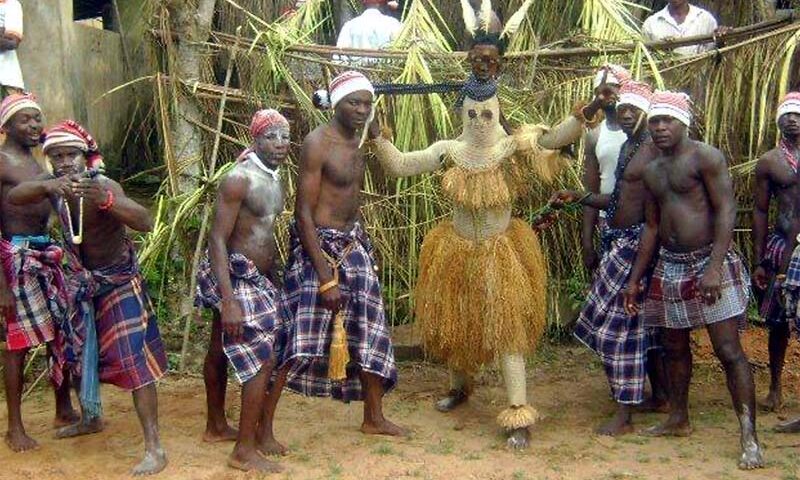
HOW THE ISIUGWU OHAFIA COMPOUNDS WERE FORMED
Ndi Agwu
This is the first compound to be founded in Isiugwu. An Ndi Agwu person, meaning an Ebem Ogo person, also founded Ndi Emele in Ekelu Ogo. Ndi Agwu Compound is said to have been founded by Agwu Ebe. Agwu Ebe was said to be the grandson of the Udumali.
Agwu left their Ikoro Ukwu residence for what is today Ndi Agwu. It was then a hamlet before it became a compound.
From Ndi Agwu, Emele Oke of the same Umu Aja maternal family as the Udumali, probably his younger brother or nephew, founded Ndi Emele. It is reported that Emele, a very wealthy man, found it uncomfortable living with his maternal uncle in Ndi Agwu.
In Ohafia, though the maternal family wields an influence in certain areas of inheritance, the royalty resolves around the patriarchal family. So, in Ndi Agwu, Emele discovered that even though he was of the same maternal family as the Udumali, he had no inheritance when the founder was sharing out his royalty. Hence, he decided to form his own compound where he wielded his own influence and inheritance for himself and his children.
As first compound to be founded in Ekele Ogo, Ndi Emele is the headquarters of that upper section of the town. The people of that section gather in that compound to deliberate issues that concern them. The other compounds pay homage to Ndi Emele during the Iri Ji, New Yam Festival. It is said that because Emele was quite wealthy, he got more compounds in the community.
Isiugwu, presently numbering 17 compounds, Ekelu Ogo alone has seven of those compounds. Ebem Ogo, which has Ndi Oji as its headquarters, has six while the other two , Omaguzo and Akwu Ezubere, are New Layouts where residents now buy new plots of lands and develop as new residences. The compounds are filled due to huge population.
Ndi Emele is a very large compound. It extends all the way to the road from the motor park leading to Ndi Agwu. In fact, that road was said to be the old road to Abam. It started from the present park through the front of the Agbala Ikoro (House of the Ikoro), through the Okoko gully. The Okoko gully was the old road. It became a gully due to constant use of the road to Abam before it was abandoned and the new one constructed from park to Isiogwe. The market place is part of Ndi Emele compound. As can be seen, Emele had a large area.
Gradually, people came to Emele for lands for settlement. They would be under him.
The first that came to Emele was his security man, Ugenta Nma. Ugenta is said to be the founder of Ndi Uge. Ndi Uge is next to Ndi Emele. Uge was said to be the watchman in charge of Emele’s Nkwa. Nkwa is a collection of art pieces which to some people also served as a shrine. Nkwa is a common site in Ohafia. It can be found in Elu, Akanu, Asaga, Ndi Oji in Isiugwu. Nkwa are arts pieces depicting historical moments in Ohafia, like the Mbari of Owerri area. Nkwa may be as high as thirty feet, or could just be a gathering of art works all depicting moments in Ohafia life and times.
Emele’s Nkwa is to have been at the market place which today also serves as the town’s square. Ndi Emele owns even the community’s Trading Company area just at the park. The building was built by Isiugwu Ohafia resident members of the Isiugwu Ohafia Development Association, (IOCDA) in Calabar. The traders had wanted a place to build the company and Ndi Emele reportedly gave them the land.
After Emele gave Uge, his watchman, a space beside him, Uma, now Ndi Uma came to him for space. Ndi Uma is the third compound in Ekelu Ogo. Uma also came from Akanu Ohafia.
Then came Ochin Igen, reportedly from Ihenta Ohafia for a space where he founded Ndi Nna Ochin compound. This was followed by Ifukwu Okoro, said to be a warrior. However, the compound is named after his descendant, Okorie, just as it happened at Ndi Agwu. So, Ndi Okorie came to be.
Then came Ndi Olugu Uma compound. This compound is reportedly Ndi Emele’s Utuga of Ndi Olugu Uma.
Ndi Emele has three utuga. Utuga has its streets also. Olugu Uma was said to have come from Okon Ohafia. He was Emele’s native doctor. The native doctors, like Oji, were to appease (Igbuju Ali) the land, usually new settlements, for the founders. They were in charge of the Kamalu shrine. Some of them stayed back with their masters and were given settlements as their own to settle.
Then came Ndi Mba. Mba reportedly came from Ihechiowa or Akwa Ibom. They call themselves Ndi Mba Olugu Essien. Ihechiowa, a town close to Arochukwu, has Akwa Ibom neighbours. Ohafia people also bear Efik or Ibibio names.
The next is Ndi Ucheji. What is today Ndi Ucheji is an amalgam of four compounds: Ndi Orieke. (There is a town in Ohafia with such name), Ndi Owa Oku, Ndi Okoro and Ndi Uche Ji. Isiugwu people called them Ndi Ama Uduara. Their square, was the Ama Uduara.
The four compounds have today merged into one. But before then, they were different compounds and the Ama Uduara was their public square.
Every Isiugwu compound, like other compounds in Igboland, has its public square, ifu ezi. The Ama Udara people have today been submerged into Ndi Ucheji due to a historical factor (war) which we shall recount later on.
Many people see Ndi Ucheji as the custodian of the Ekpe masquerade. But it is not really true. What happened was that the founder of Ndi Okoro had asked the Udumali that if the Ekpe would visit him, he would present him with a human being. Then, it was a fashion to use human beings as sacrifice. The Udumali was said to have agreed.
The reason was that once the Ekpe left the Okpukpu Ekpe, the tree under which it is decorated and donned, it would meander its way to Ndi Agwu to pay homage to the royalty and receive royal blessings.
From there, it would move to Ndi Emele. But because it left the Okpupku Ekpe with a cutlass, Okoro had asked that once he presented the Ekpe with a human gift, it would no more carry the cutlass. Instead, a broom would be given to it. It was to become a friendly masquerade. This was agreed. When the Ekpe visited him, Okoro presented a slave to the Ekpe which with a stroke of the knife, sliced off his head. Immediately, the knife was removed from its hand and a bunch of broom was given to it. Till today, the Ekpe, immediately after its royal blessing at Ndi Agwu, goes to Ndi Okoro next, instead of Ndi Emele, to receive a broom.
Ama Uduara is now eclipsed by Ndi Ucheji. It is said that Okoro descendants founded Ndi Okoro Oku. The different compounds have also become part of the Ndi Uheji’s umudi.
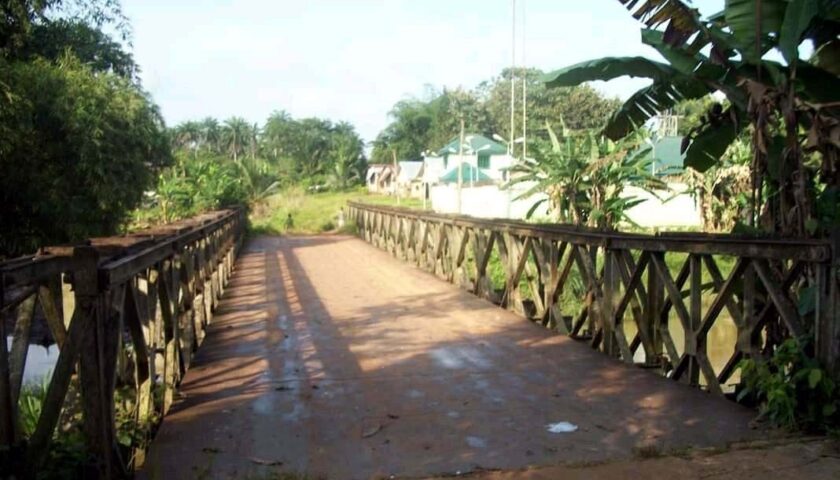
EBEM OGO
Ndi Agwu. We have already discussed how this compound, which is the head of the Isiugwu Ohafia community, was founded.
Ndi Agwu is followed by Ndi Eziukwu. It was founded by Oji, nicknamed Echele -Oji Echele. He came from Okposi. A native doctor to the Udumali, he was to appease or calm (Igbuju) the land for the Udumali. He lived next to Udumali, at Ndi Eziukwu. From Ndi Eziukwu, he moved to Ndi Oji. Ndi Oji is the head of Ebem Ogo, and is the largest and most populated in the town. Invariably, Oji founded two compounds in Isiugwu and both see themselves as one.
The next is Ndi Okpo. Its founder, Okpo, is said to have come from Ihechiowa.
Ndi Agwu Okoro Oku Compound, which is between Ndi Okpo and Ndi Oji, is said to have come from Ndi Okoro when they were displaced by war, along with Ndi Orieke, then of Uzo Okpuru, the Cherubim area, Ndi Okoro. They are in Ndi Ucheji.
ISIUGWU AND OHAFIA MATRILNEAL AND PATRILINIALINHERITANCES
As noted in the reason why Emele Oke left his maternal uncle, Mba, Ohafia, indeed has maternal inheritance but it is not wholly matrilineal. It is therefore wrong to describe the people as a matrilineal as Dr. Nsugbe wrote in his book, Ohafia, the matrilineal people of the Igbo Njoku Ukariwe would say Ohafia’s matrilineal culture is not to the core.
Ohafia, Ukariwe said, is a mix of both matrilineal and patrilineal inheritances.
The matrilineal family, called Ikwu, owns farm lands in Isiugwu and other Ohafia towns. However, patrilineal families, called Umudi, own the compounds (ezi) and also farm lands. This can be found in Ohafia towns of Asaga, Okon, Akanu, Amaekpu etc. In Isiugwu, the umudi has no farm lands. It is the ikwu that has lands.
If the Udumali could not give inheritance to his maternal brother or nephew, Emele, it tells a lot about the inheritance formula in Ohafia.
Royalty in Ohafia is paternal. It is only in Ebem that the monarchy is maternal, and even then, the Ezieogo is a man. He emerges from his maternal family. Even the heads of the maternal families, ikwu, are all male.
The umudi inherits the royalty and owns the ezi, the compounds. The man’s children own their father’s houses.
After the burial of a man, during the imawa Akwa, tying of clothes, it is the umudi that do that. Umudi is the paternal lineage of the man. It is usually his compound people. Imawa akwa is the sharing of the man’s property to his children. The first son takes his share, followed by the second, the daughter takes, then others. An okwara umudi, an uproot man, is appointed to oversee the sharing.
HOW IKWU BEGAN TO TAKE A MAN’S PROPERTY AFTER HIS DEATH
In explaining how the ikwu began to take their men’s property in Ohafia, Ukariwe said it happened long ago. The case was about a murder committed by a man. His father was approached to solve the son’s murder case. The solution involved the replacement of a child for the murdered person’s family by the murderer’s father. But the father asked his son, the murderer, to go his mother’s people for the replacement. It was his sister that brought out her child for the replacement. The man then decreed that his mother’s family would be inheriting his property. And it had come to stay. Ohafia, Abam, Abiriba, Edda practise this culture.
A closer look at this story actually creates some loopholes. First, did the sister have the power to offer her child for exchange? How did the rest of the community begin to take after the murderer’s practice? How did the new practice affect the existing structure?
Indeed, the Ohafia migratory story shows that the people in their journey to the Ohafia land, met with largely matrilineal people within the Niger Delta, such as the Ikwerre where they stayed for some time and with the Ijaw.
The Ikwerre, an Igbo sub ethnic group, along with some ijaw groups, have strong matrilineal influence. It is not a surprise that the Ohafia would have such influence too. The people have dialectal inflexion associated with the Ikwerre and Etche of Rivers state.
IKWU INHERITANCE
Ukariwe said when a man died; some of his maternal members would lock up the man’s house. They would take the property of the man, leaving the man’s house for the children empty.
If the man bought a land outside his Ulo ezi, compound house, and was silent on who takes charge of it, the ikwu could farm it. That leads to conflict today between the ikwu and the man’s children.
Such practice, Ukariwe noted, is no more in existence. In most other Ohafia towns today, the children take their father’s property, no matter where it is located.
The changes are happening because of laws enacted by government, and the influence of modern development. Sometimes, negotiations between the man’s ikwu and his children take place in cases the man is silent on how to share his property.
The elder gave an illustration on how even in Isiugwu, the children are taking over their fathers’ properties, even those ones he built outside the village.
It was a house owned by an Isiugwu Ohafia man in Enugu. The ikwu wanted to take over the house. But the children sold the house, against the cultural practice. The children went to court and the court threw its weight behind the children. The children won. And the matter died a natural death.
But Ukariwe said such practice is changing greatly in Ohafia. It is becoming unreasonable that a man, his wife and his children would struggle to acquire property only for the maternal family to take it. Some men are now writing their own wills or telling their umudi and others on how they want their properties shared.
He said it is important that a man leaves a will behind on how to share his properties to avoid any rancour. He can call his umudi too, among others, if unwritten, and tell them how he wants to share his property.
THE MAN OJI
Oji, said to have come from Okposi, was said to have been a native doctor, who was brought in by Mba to appease the land. The appeasement called Igbuju Ali was the practice done when a person wanted to settle in a new place. Ndi Oji people are the ones that perform the Nwachukwu dibia ceremony before Isiugwu people would plant azima. It is a re-enactment of the igbuju ali


